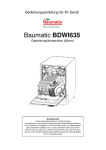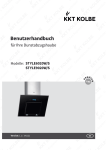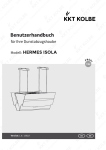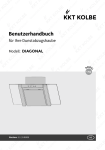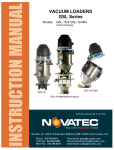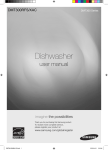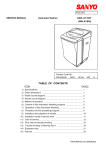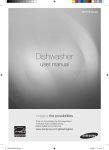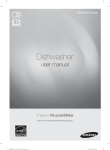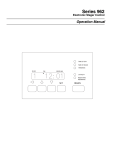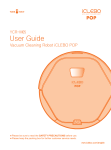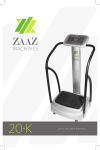Download User's manual - page screenshot of kolbe
Transcript
User’s manual for your dishwasher Model: GSI61ED Version: 1.0 / 140610 EN Hints and symbols Dispose of the dishwasher packaging material correctly. All packaging materials can be recycled. Plastic parts are marked with the standard international abbreviations: (e.g. PS for polystyrene, padding material) This appliance is identified according to the European guideline 2002/96/EC on waste electrical and electronic equipment -WEEE. The guideline specifies the framework for an EU-wide valid return and re-use of old appliances. This icon indicates a hazardous situation. You‘ll find it especially with all descriptions of the steps that might cause danger to persons arising. Observe these safety instructions and behave accordingly careful. Enter these warnings also to other users of the device. ! This icon indicates a warning. You can find it in the description of the steps that must be observed in order to damage to the unit can be prevented. Please include these safety instructions to all device users. This icon indicates an information. This symbol indicates useful tips and calls attention to proper procedure and behavior. The observance of the notes marked with this icon may save you many problems. When using your dishwasher, follow the basic precautions including the following: Hydrogen gas is explosive Under certain conditions, Hydrogen gas may be produced in a hot-water system that has not been used for two weeks or more. Hydrogen gas is explosive. If the hot-water system has not been used for such a period, before using the dishwasher turn on all hot-water faucets and let the water flow from each for several minutes. This will release any accumulated hydrogen gas. As the gas is flammable, do not smoke or use an open flame during this time. Warning! Proper use: • Do not abuse, sit on, or stand on the door or dish basket of the dishwasher. • Do not touch the heating element during or immediately after use. • Do not operate your dishwasher unless all enclosure panels are properly in place. Open the door very carefully if the dishwasher is operating. There is a risk of water squirting out. • Do not place any heavy objects or stand on the door when it is open. The appliance could tip forward. • When loading items to be washed: Locate sharp items so that they are not likely to damage the door seal; Load sharp knives with the handles up to reduce the risk of cut-type injuries; • Warning: Knives and other utensils with sharp points must be loaded in the basket with their points down or placed in a horizontal position. • When using your dishwasher, you should prevent plastic items from contacting with heating element. • Check that the detergent receptacle is empty after completion of the wash cycle. • Do not wash plastic items unless they are marked dishwasher safe or the equivalent. For plastic items not so marked, check the manufacturer‘s recommendations. • Use only detergent and rinse additives designed for an automatic dishwasher. Never use soap, laundry detergent, or hand washing detergent in your dishwasher. • Other means for disconnection from the supply must be incorporated in the fixed wiring with at least 3mm contact separation in all poles. • Keep children away from detergent and rinse aid, keep children away from the open door of the dishwasher , there could still be some detergent left inside. • Young children should be supervised to ensure that they do not play with the appliance. • This product is not designed for use by persons (including children) who have reduced physical, sensory or mental capacities or persons with no experience or knowledge, unless they are instructed and supervised in the use of the appliance by a person responsible for their safety. • Dishwasher detergents are strongly alkaline. They can be extremely dangerous if swallowed. • Avoid contact with skin and eyes, and keep children away from the dishwasher when the door is open. • The door should not be left in the open position since this could present a tripping hazard. • If the supply cord is damaged, it must be replaced by the manufacturer or its service agent or a similarly qualified person in order to avoid a hazard. EN Safety Information Konformiditätserklärung • During installation, the power supply must not be excessively or dangerously bent or flattened. • Do not tamper with controls. • The appliance is to be connected to the water mains using new hose sets, and the old hose-sets should not be reused. • Make sure that the carpet must not obstruct the openings at the bottom base. • Use the dishwasher only for its intended function. • The dishwasher is intended for indoor use only. • The dishwasher is not designed for commercial use. It is intended for use in domestic households and in similar working and residential environments. Packaging material could be dangerous for children! For disposing of package and the appliance please go to a recycling centre. Cut off the power supply cable and make the door closing device unusable. Cardboard packaging is manufactured from recycled paper and should be disposed in the waste paper collection for recycling. By ensuring this product is disposed of correctly, you will help prevent potential negative consequences for the environment and human health, which could otherwise be caused by inappropriate waste handling of this product. For more detailed information about recycling of this product, please contact your local city office and your household waste disposal service. Congratulations on the purchase of your new dishwasher! We recommend that you spend some time to read this Instruction / Installation Manual in order to fully understand how to install correctly and operate it. For installation, please read the installation section. Read all the safety instructions carefully before use and keep this Instruction / Installation Manual for future reference. 4 Table of content 7 2. Device description 2.1 Control panel 8 3. Using your dishwasher 3.1 Before the first use 3.2 Loading salt into the softener 3.3 Set up the water softener 3.4 Fill the rinse aid dispenser 3.5 Adjusting the rinse aid dispenser 3.6 Loading the upper basket 3.7 Adjusting the upper basket 3.8 Loading the lower basket 3.9 Folding racks 3.10 Cutlery basket and fork shelf 10 4. Starting a washing program 4.1 Wash cycle table 4.2 Changing the program 4.3 At the end of the cycle 4.4 Forget to add dish 4.5 Set up the delayed start 4.6 Refill signal lamps 4.7 3-in-1-Function 4.8 Key lock 19 5. Energy saving 23 6. Maintenance and clearning 6.1 Filter clearning 6.2 Maintenance and cleaning 6.3 Cleaning tips 24 EN 1. Specifications 1.1 Product specifications 1.2 Informations about energy efficiency 7. Troubleshooting 7.1 General troubleshooting 27 8. Information sheet 31 5 My device For future reference please record the following information, which can be found on the nameplate. Also, please note the date of purchase of your device that is on your invoice. The rating plate of your dishwasher is located on the right inside of the hinged door. 6 Model number: Serial number: Date of purchase: General Information 1. Specification Dimensions: EN Height: 810-885 mm Width: 596 mm Depth: 578 mm Dimensions of the mounting cut-out: Height: 810-885 mm Width: 600 mm Depth: 598 mm 1.1 Product specifications • 12 Place settings • 6 programs: ECO Intensive Light Rapid Crystal 1 hour • 4 Temperatures: 40°C, 45°C, 46°C, 60°C • Delayed start • LED-Display • 3 in 1-Function • Self-cleaning stainless microfilter • Aqua-Stop • Waterproof-System • Concealed radiator • Height-adjustable upper basket • Tiltable plate holder • Adjustable feet • Water consumption: 13 Liter • Noise emissions: low 1.2 Daten zur Energieeffizienz Energy efficiency class: A++ Electrical Information Cleaning performance class: A Rated voltage: 220-240 V 50 Hz Drying performance class: A Maximum connection value: 0,92 kW Energy consumption Fuses: 16 A Off-Mode: 0,35 W Stand-By-Mode: 0,90 W 7 Device description 2. Device description 9 8 2 3 5 4 10 6 7 1 Upper Basket 2 Spray Arms 3 Lower Basket 4 Water Softener 5 Filters 6 Detergent Dispenser 7 Rinse Aid Dispenser 8 Cutlery basket 9 Fork shelf 8 1 Control panel 2.1 Control panel 9 10 13 EN 6 3S ec 1 7 8 2 3 11 12 4 5 1. Power switch: To turn on/off the power supply. 2. Program key: Press the key to scroll through the wash cycles. The corresponding program light will be ON to indicate which WASH CYCLE has been selected. 3. „3-in-1“-Button: Press this button - you can choose or cancel the 3-in-1-Function. 4. Delay button: The start delay will allow you to delay the start time of any cycle automatically up to 24 hours. 5. Start/Pause-Button: The appliance will start or pause the expected washin cycle. 6. Program indicator lamp: When you select a washing program, the corresponding lamp will light up. 7. Rinse aid refill indicator: The indicator lights up when dispenser needs to be refilled. 8. Salt refill indicator: The indicator lights up when the softener needs to be refilled. 9. 3 in 1 indicator: The indicator lights up when the additional function is selected. 10. Washing light: Appears when the washing process is running. 11. Child lock indicator: The „Child lock“ will be available when you press the 3 in 1 button and Delay button at the same time for 3 seconds. 12. Drying light: To come on when the dishwasher is drying. 13. Digital display: Displays the running time remain, malfunction codes and delay time. 9 Using the dishwasher 3. Using the dishwasher 3.1 Before first use • A. Set the water softener • B. Pour 500ml of water inside the salt container and then fill with dishwasher salt • C. Fill the rinse aid dispenser • D. Detergent 3.2 Loading the salt into the softener Important Always use refined salt, which is intended for the dishwasher. If you take a different kind of salt (in particular table salt), the water softener is damaged. • Remove the lower basket and then unscrew and remove the cap from the salt container. • If you are filling the container for the first time, fill 2/3 of its volume with water (around 500ml). • Place the end of the funnel (supplied) into the hole and introduce about 2kg of salt. It is normal for a small amount of water to come out of the salt container. • Carefully screw the cap back on. • Usually, the salt warning light will be off in 2-6 hours after the salt container is filled with salt. 10 Using the dishwasher Important Information EN The next refilling of salt in a dishwasher refilling of 500 ml of water in the reservoir of the water softener is not necessary. 3.3 Set up the water softener The water softener has to be set manually. This feature is built in your device to remove minerals and salt from the water, which would have a detrimental or adverse effect on the operation of the appliance. The higher the amount of these particles, the harder the water is. The softener should be adjusted according to the hardness of the water in your area of living. Inform yourself at your local water authority about these values. Setting: • Unscrew the cap from the salt container. • There is a ring on the container with an arrow on it (see figure to the side). The ring must be rotated towards the „+“ sign and refill the container with salt. °Clark Range Mmol/l Value • Close the cap and the appliance door. 0–8 soft 0–1.1 H0 • Turn the appliance on. 9–10 soft 1.2–1.4 H1 • Hold down -button and press -button for about 5 seconds. The buzzer rings one time and H4 appears on the screen (standard value). 11–12 medium 1.5–1.8 H2 13–15 medium 1.9–2.1 H3 16–20 medium 2.2–2.9 H4 • To change the value according to the table, press -button till you have reached it. 21–26 hard 3.0–3.7 H5 27–38 hard 3.8–5.4 H6 • Press 39–62 hard 5.5–8.9 H7 to store your setting. 11 Using the dishwasher 3.4 Fill the rinse aid dispenser Rinse aid is automatically added during the last rinse, ensuring thorough rinsing, spot and streak free drying. • This appliance has been designed for the use of liquid rinse aids. • The dosage of the rinse aid is on the inside of the tiltable door, next to the Chamber of the dosage of dishwasher tablets. • To make the rinse aid reservoir of accessible, turn the cap counterclockwise, the cap is thus loosened from the filling opening (1). Pour slowly the liquid rinse aid (2); the capacity of the reservoir is about 110 ml • You should pour in the rinse aid slowly until the level indicator is completely black. • You should not overfill the reservoir, it could cause the selected wash program for excessive foaming. Wipe off the remains of the rinse aid with a damp cloth. • Unscrew the cap clockwise back again until it locks into position (3). • If the control indicator „Rinse aid“ on the control panel on, it is necessary to fill the detergent reservoir again. • Important: Even if you use detergent tablets 3 in 1, it is necessary to constantly refill rinse aid into the reservoir. If there is no rinse-aid warning light on the control panel, you can judge the amount of rinse-aid by the color of the optical level indicator „D“ located next to the cap. When the rinse-aid container is full, the whole indicator will be dark. As the rinse aid diminishes, the size of the dark dot decreases. Full 3/4 full 1/2 full 1/4 full - Should refill to eliminate spotting Empty 12 1 rinse aid indicator 2 Using the dishwasher 3.5 Adjusting the rinse aid dispenser EN The amount of rinse agent that consumes the dishwasher, also depends on the water hardness. With the setting of the rinse aid dosage you should experiment until you find the optimum setting that ensures the best results. • We recommend that the first flushing adjust the rinse aid dispenser at number 4. • If there are water spots on the dishes or the dish is not dry enough, move the arrow counter-clockwise and set it to the next higher number. • Set the rinse aid dosage to no water stains will last as long a upward. • If there are streaks and stripes on the dishes, the setting of the rinse aid dosage could be too high. This causes foam during the flush. Move the arrow clockwise to the next lover number. Dosage of dishwasher tablets The dosing of the detergent must each time the flushing are filled (except for the flush mode). • Open the lid of the detergent container (1) and fill in the detergent (2). 13 Using the dishwasher 1 2 • The chamber on the picture (1) is intended for detergent of the main washing program. In the detergent dispenser only one tablet of detergent is inserted. If you use powder detergent or liquid detergent, follow the recommendations of the detergent manufacturer. • The chamber on the figure (2) contains an extra detergent, namely for each flushing, which has a Vorspülungsfunktion; but this is only an optional extra function. This is only for powder detergent or liquid detergent, not for tablets. • Close the lid of the detergent container and on the outside edge make the clip so that it keeps the lid closed. • The clip opens after the rinsing operation is started and the tablet / powder / liquid are dosed into the dishwasher. Intensive detergent • The use of the program for normal rinsing in conjunction with reducing a intensive dishwashing liquid contamination and is suitable for your dishwasher. This dishwashing corresponds to the specific enzymes that dissolve the dirt particles and are included in the concentrated dishwashing detergents. • For this reason, when selecting the normal wash cycle using dishwasher detergent the same result as „Intensive“ can be achieved. Detergent tablets • The detergent tablets of different brands dissolve at different rates. For this reason some detergent tablets do not dissolve during the short wash cycles and can thus develop a sufficiently effective cleaning power. • Therefore always choose a longer program, if you use the detergent tablets, to remove all residues during the flushing process. 14 Using the dishwasher 3.6 Loading the upper basket A Cups B Glasses C Saucer D Serving bowl E Serving bowl • The dishes are to be distributed such that it does not move during the wash under the pressure of the water flow. • Use the picture as a guide to the distribution of the dishes in the dishwasher. * The procedure for loading the cutlery tray on the upper rack, refer to the corresponding page. EN The upper basket is designed for gentle rinse of the sensitive, fragile and smaller dishes pieces, eg of glasses, cups, small plates, bowls and shallow pans (if they are not heavily soiled) provided. A B B E B B B B B B B C D B B B 3.7 Setting the upper rack position Your dishwasher has an height-adjustable upper basket, making the optimum height position of the upper basket, which can be achieved by the rinsing of pickled crockery. The height of the upper basket can be achieved by situating the wheels be set in the other plane of the guide rails. Long objects should be placed in the cutlery tray to prevent collisions with the spray arms. When removing the basket from the guides The basket must be empty. For easier positioning of pots and Pans, the position of the upper tray has to be changed. 15 Using the dishwasher 3.8 Loading the lower basket The lower basket is designed for large and more dirty dishes, such as Pans, pan lid or serving dish suitable. In the lower basket, you can also insert mugs and various plates. H Plates I Dessert Plates J Oval plates K Soup plates • Depth kitchen pans are inclined position so that the water can flow from the pans. 3.9 Foldable stand the lower rack • The lower bracket has at the back of the basket folding holder that can be folded down, making it easier to load large kitchen pans and serving dishes. 16 1 2 Using the dishwasher 3.10 Loading the cutlery baskets EN In the lower basket, the cutlery should be placed with handles at the bottom. For optimum sweep efficiency to use the already connected to the basket place net and put the cutlery individually into the appropriate slots. Especially long utensils should be at the front of the upper basket (pictured right), placed in a horizontal position. 1 8 1 2 3 4 5 6 7 8 7 1. Teaspoon 2. Dessert spoons 3. Soup spoons 4. Ladle 5. Skewers 6. Fork 7. Knives 8. Salad / Serving 8 • The kits are lodged in the cutlery basket on the top holes for achieving the best cleaning results. ! Important Avoid falling through the cutlery through the bottom of the cutlery basket, as it could cause damage to the spray arm and / or own cutlery. If the bottom of the cutlery basket begins to deform and thereby enables falling through the cutlery, so replace the cutlery basket. 17 Using the dishwasher Don’t try to wash rags, sponges or other items that suck the water rinse. • Before loading the dishes into the dishwasher to remove food debris and soak the burnt food residues on the pans on. • After loading the machine, check that the spray arms can rotate freely. If the spray arm in the rotation come into contact with the dishes, change the distribution of pickled dishes. • The cups, glasses, pans, etc., are always insert with the bottoms up so that the water can not collect in them. • Cutlery and crockery may not cover each other; this could lead to insufficient rinsing. • Avoid contact with each of glasses in the dishwasher, it could cause damage to them. • Small objects can be placed in the cutlery basket. The following items are not suitable for washing: • Cutlery with mother of pearl, wood, horn or porcelain handle. • Plastic items that are not heat resistant. • Cutlery with glued parts that are not temperature resistant. • Cutlery or glued Earthenware • Copper or pewter • Lead crystal glass • Wooden bowls • Articles made from synthetic fibers The following items are suitable for washing only partially. • Earthenware dishes must be washed in the dishwasher only if the manufacturer declares for the dishes to be suitable. • Plastic objects (eg food storage containers) may be washed in the dishwasher only if the manufacturer declares it to be suitable. • Glazed Earthenware may fade after many washings in the dishwasher. • Silver and aluminum objects can change the color in the dishwasher. 18 Washing programs Program Intensive ECO (*E 50242 standard program) Light 1h 1 hour Rapid Pre-Rinse Program information For the heaviest soiled loads, such as pots, pans, casserole dishes and dishes that have been sitting with dried food on them for a while. For normally soiled loads, such as pots, plates, glasses and lightly soiled pans. standard daily cycle. Light wash cycle to be used for more delicate items which are sensitive to high temperatures. (Run cycle immediately after use) For lightly and normally soiled plates and pans for every day. A shorter wash for lightly soiled loads that do not need drying. To rinse dishes that you plan to wash later that day. Dishwasher cleaner for pre- and main wash Running time (min) Energy consumption (KWh) Water consumption (l) 5/25 g (or 3 in 1) 180 minutes 1,30 16 5/25 g (or 3 in 1) 172 minutes 0,92 11 5/20 g (or 3 in 1) 137 minutes 0,85 14 5/20 g 60 minutes 0,95 10 → Hot rinse 15 g (Main washing) 39 minutes 0,50 7 → Pre-wash – 11 minutes 0,01 4 Cycle description → Pre-wash → Main wash(60°C) → Rinse 1 → Rinse2 → Hot rinse → Drying → Pre-wash → Main wash (46 °C) → Hot rinse → Drying → Pre-wash → Main wash (45° C) → Hot rinse → Drying → Hot rinse 1 → Hot rinse 2 → Hot rinse(60°C) → Drying → Main wash(40°C) 19 EN 4. Overview Using the dishwasher ! The Washing program „ECO“ is „medium“ for the flushing of the suitable soiled dishes and most efficient in terms of combined energy and water consumption. The fair values of the washing program are a guideline only. Circumstances that are not dependent on the device, for example the temperature of the supplied water, the water pressure, etc., may affect the overall duration of the wash cycle. * Default program, according to the test cycle. 4.1 Set up the washing program Make sure that notes from the first section have been complied with „before first use“. 1. Check the status of the rinse aid and refined salt. 2. Pull out the upper and lower basket and clear up the dishes - see instructions for loading the dishwasher. 3. Press the lower and upper basket back in place. 4. Fill in the washing detergent. 5. Turn the dishwasher off using the ON/OFF-button. Wait before pushing the program selection button for 5 seconds, otherwise it could happen that the consumer is not working properly. 6. Press the program selector button and select the appropriate program in order for the installed harness. The program indicators show you which wash program you have selected. 7. Select the program you want to use. 8. Close the door firmly until you hear a click of the door lock. 9. After a few seconds you will hear how the machine fills with water and as the wash cycle begins. 20 ! Using the dishwasher 4.2 Changing the washing program The change of the washing program should be carried out immediately after the start of the program, otherwise the tablets could be already solved or hot water may be leaking. EN ! 1. Slowly open door of the appliance. 2. Wait about a minute until they open the door fully so you can be sure that the spray arms stop working. 3. Press the program selector button and hold it down for 3 seconds to cancel the wash program. Then press the program select button to select the wash program. 4. Select the program you want to use. 5. Close the door firmly until you hear a click of the door lock. 6. After a few seconds you will hear how the machine fills with water and as the wash cycle begins. 4.3 At the end of the washing program 1. The audio signal will ring 6 times. 2. Turn the dishwasher off using the ON/OFF-button. 3. Before taking out the dishes we recommend that you wait at least five minutes in order to avoid taking out dishes that still may be hot or fragile. The dishes are also better dry if you leave it longer in the open dishwasher. 4. Open the door and take the dishes out. 4.4 Additional loading of dishes ! The additional loading of the dishes in the dishwasher is only possible when the washing program has just been started, otherwise the detergent may leak and the water leak. 1. Slowly open the door of the dishwasher and wait until the spray arms stop working. (Risk of burns) 2. Now you can fully open the door and additionally load the dishes in the dishwasher. 21 Using the dishwasher 4.5 Set up the delayed start You can set the delayed start of the program with a deferment until 24 hours. The delayed start can be set at hourly intervals. 1. Set the washing program described one above. 2. Press the button to select the washing program and choose the one you want to use. The corresponding washing program lamp lets you know which wash program you have selected. 3. Press the button for the delayed start. 4. Press the button for the delayed start until the desired time (1, 2, 3, ... 23, 24 hours) is displayed on the LED-display. 5. After the expiry of the set time the wash cycle is started. 4.6 Refill signal lamps • The pilot light dishwasher. indicates that you should fill the rinse aid into the • The pilot light washer. indicates that you should fill the salt in the dish- 4.7 3-in-1-function If you use the 3-in-1 tabs, press the 3-in-1 key and the machine adjusts the purging sequence of these tablets. 4.8 Key lock / Children lock • You can lock the control panel to avoid unintended interference. All buttons are without function. • Press the 3-in-1-button and the button for the delayed start at the same time and hold it for 3 seconds to switch the key-lock on and off. 22 Energy saving EN 5. Energy savings when using the dishwasher Load the dishes • When loading the dishes into the dishwasher you please follow the instructions in the relevant chapter of this manual, in order to achieve the optimum results. • Turn the dishwasher only when it is full; Way you achieve the optimal energy and water utilization. • To select the most efficient wash cycle according to the size and type of fill, you go through the program table. • The austerity program washing dishes at a lower temperature and uses less water during the cycle. This makes it more environmentally friendly and helps reduce expenditure on energy and water. Application • All filters must be cleaned regularly to ensure that the dishwasher is clean and gets its efficiency. • After use, do not forget to switch off the dishwasher. If the unit remains in standby mode, each year large quantities of energy are wasted. • Before loading the dishes into the dishwasher, the dishes must not be rinsed off. If you prefer the pre-rinse, use cold water for the dishes, but do not waste the water and do not let it flow uninterrupted. • For dishes which is not too much dirty, use shorter programs with a lower temperature. Shorter programs need less energy and work equally well. Modern dishwashing detergents have the same effect at lower temperatures. 23 Maintenance and cleaning 6. Maintenance and cleaning Before cleaning, please turn off the power. Filter system Your device is equipped with a three-stage filtration system that is due to a good access to the bottom of the dishwasher. 1 Coarse filter 2 Flat filter 3 Micro filter Coarse filter: Big debris, such as bone and glass that could clog the drain will be trapped in the coarse filter. To remove an item caught in this filter, gently squeeze the taps on the top of this filter and lift it out. Flat filter: Food and debris will be trapped by a special jet on the lower spray arm. Micro filter: This filter holds soil and food residue in the sump area and prevents it from being redeposit on the dishes during a cycle. Even if the filter system is effective, don’t use your dishwasher for waste disposal. All items that are washed in the dishwasher are to free before loading from all the food groups. 24 Maintenance and cleaning 6.1 Filter cleaning EN To achieve the highest efficiency and best results, the entire filter unit is always thoroughly and regularly (ideally after each wash cycle) to clean. 1.Turn the coarse filter counterclockwise and pull it in the direction upwards. Rinse this part under running water and remove all food residues that have attached themselves to the filter. 2.Pull the main filter out and rinse it off under running water to remove all food residues that have been attached to the filter. 3.Pull out the fine filter and rinse it off under running water to remove all food residues that have been attached to the filter. 4.Remove the fine filter back in. 5.Remove the main and coarse filter back into the space provided in the base of the dishwasher one. The coarse filter must be turned in a clockwise direction, so that it locks in the correct position. ! If dish breaks in the device, make sure that all fragments were removed before the machine is started again, so as not to damage the unit. Never turn on the wash cycle when the filters are not installed! 6.2 Cleaning the spray arms The spray arms should be cleaned regularly to avoid clogging of the nozzles in the spray arms and the bearing with hard water deposits. • To remove the spray arm, first unscrew the nut and remove the washer, which is placed on the upper part of the spray arm. 25 Maintenance and cleaning • Remove the spray arm gently upwards to remove the lower spray arm. • Spray the spray arm with hot water and soap to clean the nozzles using a fine brush. • Rinse the spray arm thoroughly and then reassemble at the designated place. 6.3 Cleaning tips ! When cleaning the operation panel or operating parts, never use abrasive cleaners or polishes for furniture care. • Wipe the control panel please only with warm water and a damp, clean wiping cloth. Cleaning the door • Only use a soft, damp cloth for cleaning the door edge. • To clean the oven door any cleaner in spray cans, because thereby the locking mechanism or electrical components may be damaged. • For indoor and outdoor areas do not use abrasive cleaners as they may damage them. Other cleaning tips • If you (for example holidays) don’t use it a long time, it is recommended to run a wash cycle with no dishes inside, then you can disconnect the power plug and the water supply. • Leave after the washes the door slightly ajar so that moisture and odors are not closed inside. 26 Troubleshooting 7. Error code system EN If your device finds that it is not working properly, warning lights can flash. In the following error codes you may be able to eliminate the error itself, you should consider the following instructions. Before starting maintenance work, the device must first be disconnected from the power supply. Error code Meaning Possible causes E1 Door open The door is opened when the dishwasher is operating. E2 Water inlet Water inlet malfunction. E3 Water drainage Water drainage malfunction. E4 Temperature sensor Temperature sensor malfunction. E5 Overflow/leakage Overflow occurs/Water leakage occurs. E6 E7 Water leakage Water leakage occurs. Heating element Abnormal heating. E2: The water refill duration is longer than expected. • • • • Check the water pressure in the water distribution lines. Clean the filter in the water supply hose. Make sure that the water supply hose is not knotted or kinked. Make sure that the water tap is connected to the device, is completely open. 27 Troubleshooting E3: The expiration period is longer or extended. • The drain pipe can be located too high or wrong. Read the installation instructions and make sure that the installation is proper. • Check that the drain hose is not knotted or kinked. • Make sure that the drain hose is not longer than the length of the original hose. E3: The unit found presence of water in the case of the dishwasher. • Check that the drain hose is not knotted or kinked. • Check if there are congested locations in the drain hose or if maybe the drain system is clogged to which the washer is connected. • The drain pipe can be located too high or wrong. Read the installation instructions and make sure that it is properly installed. • After you correct the error that led to the display of the error codes, connect the power back to the power supply. • Switch the dishwasher on with the ON / OFF button and wait 5 seconds before you set your own program using the program selection buttons. ! Once you were able to fix the error that led to the display of the error codes, connect the power back to the power supply. Switch it using the ON / OFF button again and wait 5 seconds. Once you were able to fix the error did led to the display of the error codes, connect the power back to the power supply. Switch it using the ON / OFF button again and wait 5 seconds. ! 28 If repair costs incurred during the warranty period due to improper operation of the unit, the customer must pay these costs themselves. Troubleshooting 7.1 General diagnosis Mögliche Ursachen Abhilfe The dishwasher doesn’t work. The fuse has blown or the safety switch of the circuit has been actuated. Replace the fuse or set the safety switch of the circle. Shut off all other loads that are connected to the same circuit as the dishwasher. The power supply is not turned on. Make sure that the dishwasher is turned on and the door is closed properly. Make sure that the plug of the power cable is fully inserted into the socket. Low water pressure. Check that the water supply is connected properly and that the water supply line is open. The drain pump doesn’t stop. Overflow. The system is designed so that any overflow is detected. When an overflow is detected, continues to run the drain pump if the unit is powered. Sound/Noise Some noise is normal. During the rinse cycle, a certain operating sound, especially when watching the food residues are removed from the inserted objects and when the detergent dispenser pushes the tablet inside arises. The kits are not stored in the baskets or a small object has fallen into the basket. Ensure proper positioning of the objects according to the instructions for their contribution. The engine „purrs“. If the dishwasher doesn’t work for a longer period, make sure once a week, that the device is set to one of the washing programs. Otherwise, the gasket can dry out the motor and lead to higher noise level of the machine. EN Problem 29 Troubleshooting Problem Possible causes Help Foam in in the drain. Poured rinse aid. Excess or poured out rinse aid always immediately wipe. Spots on the inner wall of indulgences. There was a washing-up liquid with dye. Use detergent without dye. The dishes are not quite dry. The rinse aid dispenser is empty. Fill up on this. The dishes and the pans are not clean. Wrong program. Select a more intensive wash program. Incorrect insert. Make sure that the spray arms and the detergent dispenser are covered with no great dish pieces. Spots and streaks on the lenses and the pans. • • • • • See related sections of this manual for the determination of whether the detergent, salt and detergent levels are fine. Verify whether the dishes are loaded properly. Steam. Normal appearance. The drying and draining of water can result in the leakage of a small amount of steam in the vicinity of the door latch. Black or gray spots on the plates. The rubber on the aluminum cutlery touches the plate. To eliminate these stains, use a mediumabrasive cleaners. In the future, you always make sure that the harness is correctly inserted. Water on the bottom, inside of the device. Normal appearance. A small amount of water on the floor of the unit is normal. Leaks in the dishwasher machine. The detergent dispenser is filled or it came to the pouring of the detergent into the interior of the device. Do not over fill the detergent dispenser. The poured detergent may cause excessive foaming and overflowing. Wipe all poured liquids immediately with a damp cloth. The dishwasher is not balanced. Make sure that the dishwasher is horizontal and is balanced. 30 Extremely hard water Low input temperature Incorrect insert Wrong detergent Wrong this salt / detergent degree Manufacturer KKT KOLBE Model number GSI61ED Standard tableware sets 12 Energy efficiency class (1) A++ Annual efficiency class(2) 259 kWh Energy demand for standard cycle 0,92 kWh Energy needed for off state 0.1 W Energy needed for standby mode 0.90 W Annual water demand (3) 3640 Liter Drying performance class (4) A Standard washing cycle (5) Eco Duration of standard cycle 172 min Sound 47 dB Installation type Built-in installation EN 9. Information sheet (1) On a scale of A + + + (highest efficiency) to D (lowest efficiency). (2) Annual energy consumption for 280 standard washing cycles in the use of cold water and energy saving programs. The actual energy consumption is dependent on the application of the apparatus. (3) Annual water demand at 280 standard washing cycles. The actual water demand will depend on how the device is used. (4) On a scale of A (highest efficiency) to G (lowest efficiency). (5) This program is suitable for washing normally soiled tableware and is the most efficient from the perspective of combined energy and water consumption. 31 Thank you for reading. We wish you lots of clean dishes. Version: 1.0 / 140610
































